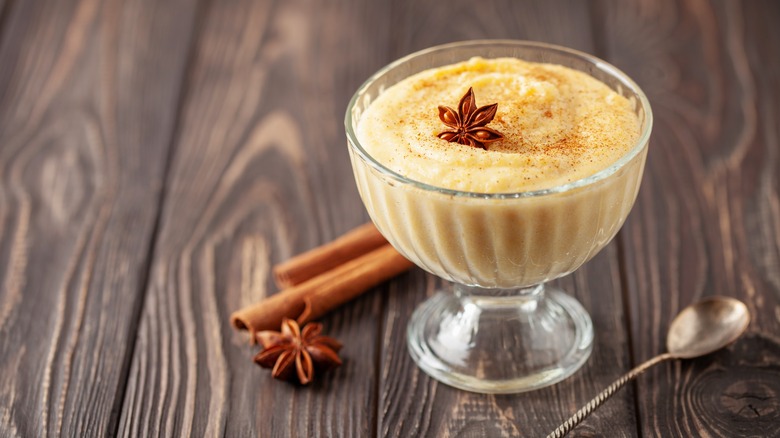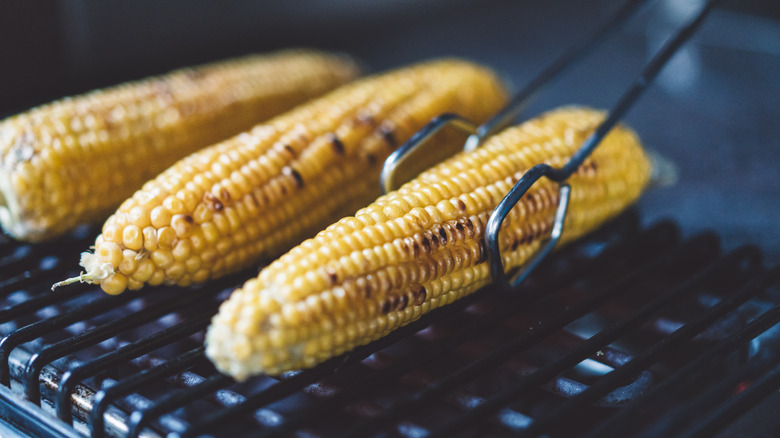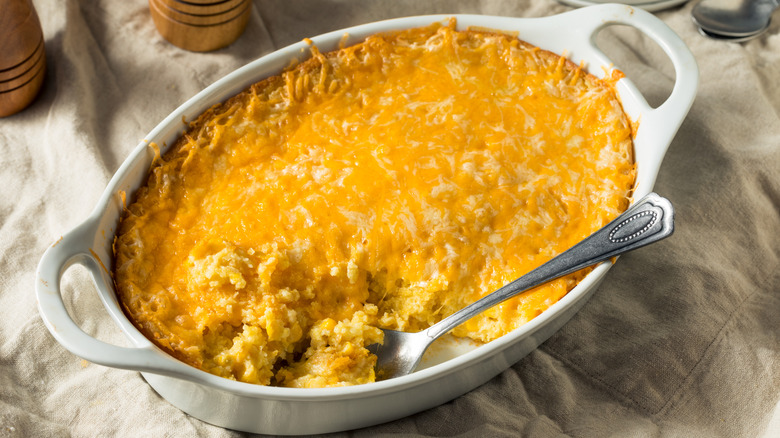Add Some Extra Flavor To Your Corn Pudding By Breaking Out The Grill
If your holiday table has yet to be graced by a deep dish of delectable, easy corn pudding, it's never too late to change your life for the better. A serendipitous combination of indigenous and European techniques and influences, savory corn pudding is as beloved in the American South as its sweet cousin curau de milho is in Brazil. And while it's not always a great idea to mess with tradition (canned corn kernels or creamed corn works just fine), making this dish with fresh corn is the way to go for many reasons — not the least of which is the opportunity to grill the ears prior to cutting off the kernels. What's not to love about a savory or sweet corn pudding made with lightly caramelized, smoky corn?
It's not necessary to thoroughly cook the ears of corn, nor will you need to go to all the trouble of brushing the husks with oil before grilling. No, this step is all about value-added flavor. A light grilling of shucked corn ears — just enough to darken some of the kernels — will be enough to elicit an earthy sweetness. (Alternatively, oven-roasting the corn will also enhance the flavor.) Then it'll be time to take that other all-important step: Cutting the kernels off the cob the right way.
Cutting and milking your way to pudding heaven
If you haven't scraped fresh corn before, just know that it has the potential of making quite a mess — the kernels are apt to fly all over the kitchen. The easiest (and most contained) method for cutting kernels off a cob is to place the ear of corn vertically in the center hole of a Bundt cake pan. To yield the most milk, it's important to cut downward with a sharp knife as close to the cob as possible, rotating as you go. The circular pan will catch all (well, most) of the kernels! If you don't own a Bundt pan, you can also use a deep mixing bowl.
Then comes the vital part: Using the dull side of the blade to scrape the "milk" off of the bare cob. It's a technique favored by Daphne Oz, who refers to it as "extra corn essence." This magic, milky liquid is not only sweet, it's starchy — and natural starch is what gives corn pudding its thickened, custardy texture. (If you have any extra left over, you can also make a drink from corn milk, as people do all over Asia as well as Central and South America.)
Take the extra step to make something unforgettable
So, given all the upsides, is it absolutely necessary to use fresh corn, lightly grilled, scraped, and milked for your corn pudding? Only if your goal is the highest possible expression of the form. Whether you're making some spicy sweet corn, green chile, and cheddar pudding as a savory side or fragrant curau de milho for dessert, these are still dishes with only a few moving parts, mostly involving dairy. So, if you spend on good milk, butter, and eggs, you're probably already prepared to do the most with fresh corn — which, after all, is going to be the star of the show. The results will be worth the effort.
In America, corn pudding is closely associated with the holiday season, which itself is closely associated with fellowship and dinner tables laden with bounty. Imbuing your corn pudding with a taste of the hearth's smokiness will only underscore the coziness of the season — and also go that much further to secure your immaculate culinary reputation.


